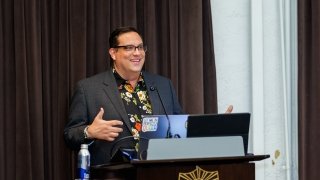“Imagine a world where young people go to school and are not afraid,” said USC Rossier Professor Theodore R. Burnes. “When they’re not afraid they get to do a lot of really cool things.” Professor Burnes, a clinical psychologist, posed this to his audience during the discussion It Takes More than a Pride Sticker: Well-being for Nonbinary Youth in Schools.
Hosted by USC Rossier, the discussion delved into the dynamics of supporting nonbinary youth within educational environments. Professor Burnes drew upon his extensive expertise in the field and offered an in-depth exploration of the unique challenges and needs of nonbinary students. The session featured strategies and practical approaches for fostering an inclusive and supportive school culture.
Highlights from It Takes More than a Pride Sticker included:
- Gender identity is separate from physiology. “It’s important for us to remember that some of us have indoor plumbing and some of us have outdoor plumbing and some of us have combinations and that that actually tells us nothing about our gender.” Burnes explained that an individual’s lived experiences of gender or their gender identity has little to do with the physiology that individuals are born with.
- Think beyond gender binary. As educators, counselors and therapists, words like LGBTQ+ have distinct groups of people. When considering the difference between gender and sexual orientation, there are also binary understandings about gender. Burnes suggests thinking beyond gender binaries because there are individuals who have a gender identity that does not fit either end of that binary pole or spectrum. “When thinking of the gender non-binary experience, it helps to hear the words of Dr. Anneliese Singh that ‘there are more genders in the world than there are stars in the sky’,” said Burnes. If educators are open to their students’ different lived experiences, students will seek guidance from their teachers. By creating open spaces for youth, students will then “be brave enough to fill them.”
- Everyone’s journey is different. Some nonbinary youth—like their transgender peers—may engage in a variety of different processes. Burnes explained that it is important to not put someone on a journey that they have no desire to get on. “Let’s get strategic as a community about what we need to do to build the school of our dreams,” he said. One way, for example, is using correct student pronouns, and recommended that schools re-evaluate their policy or stance on pronouns.
- Support training for school personnel to support students’ well-being. How should educators respond when gender bias occurs? What should be said? Learning how to respond against bias and harassment supports students’ educational environment and improves learning outcomes. When students feel validated and see themselves in that experience, they feel connected. “If we all came together and figured out ways to communicate and support one another we will move it forward,” said Burnes.
- Value and respect the cultural context of communities. “Consider the ways in which the admissions policies or documents, including online application portals, are inclusive of a variety of different gendered experiences,” Burnes added. Students seeing and hearing correct pronouns may feel safer and welcomed. By offering spaces like schools to try on different experiences and opening conversations with others outside of their family such as school counselors and teachers, students will have the opportunity and know they can be true to themselves.
Burnes shared a final thought with his audience. “As we learn from community psychologist Karl Wieck, small wins are like ripples,” he added. “When we make small changes, other people feel empowered to change with us even if they don’t yet feel empowered to make their own set of changes.” When educators and administrators consider small changes, they empower their communities’ own advocacy.
Panel video: It Takes More than a Pride Sticker: Well-being for Nonbinary Youth in Schools





